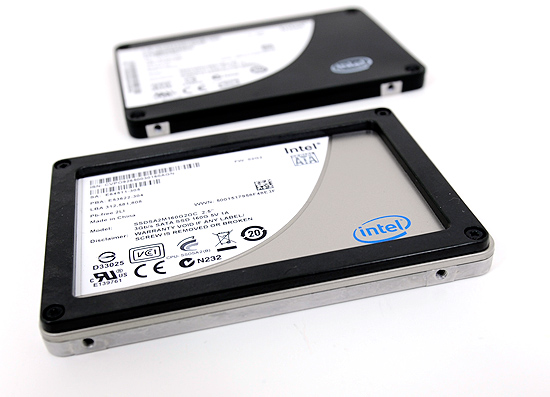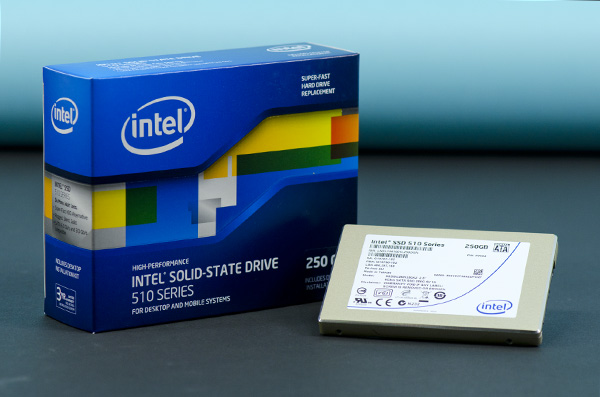The Intel SSD 510 Review
by Anand Lal Shimpi on March 2, 2011 1:23 AM EST- Posted in
- IT Computing
- Storage
- SSDs
- Intel
- Intel SSD 510
The X25-M was a tremendous first attempt by Intel to get into the SSD market. In our review of the SSD I wrote that Intel just Conroe’d the SSD market, and if it weren’t for the pesky 80MB/s sequential write speed limitation the X25-M would’ve been given the title: World’s Fastest Drive.

Its successor, the X25-M G2, was a mild update that brought prices down through the use of 34nm NAND. Remember that Intel is also 49% owner of the IMFT joint venture and as a result can be quite competitive on NAND pricing (and quite early to adopt new NAND technologies).

Intel’s goal all along was to drive down the cost of SSDs. Looking at the history of MSRPs with the X25-M (not to mention the M, which stood for Mainstream in the product name) this shouldn’t come as a surprise:
| Intel X25-M Pricing History | |||||
| 2008 | 2009 | ||||
| 40GB | - | $125 | |||
| 80GB | $595 | $225 | |||
| 160GB | $1000+ | $440 | |||
The third generation X25-M was to drive down costs even further, this time thanks to Intel’s 25nm NAND. You’d be able to get twice the capacity at the same price point as the X25-M G2. The value drive would be an 80GB offering, the mainstream drive would be 160GB and the high end drive would be 320GB.
The drive would offer higher performance. The controller was to be completely redesigned, with the “oversight” that limited sequential write speed to only 100MB/s corrected entirely. In addition, the third generation Intel SSD would add full disk encryption - making it even better suited for enterprise customers. Going after the enterprise market was Intel’s plan to really make money on SSDs in the long run. Instead of just selling corporations a CPU, chipset and wireless controller in a notebook, there would be an SSD on top of all of that. Perhaps eventually even have some security software courtesy of McAfee.
The third generation X25-M was originally due out in the middle of 2010. As is usually the case with schedules, the “G3” slipped. The middle of the year became the end of the year and the end of the year became Q1 2011.
To make matters worse, the specifications Intel was talking about for its third generation drive/controller weren’t all that competitive. We published the details last year knowing that the competition would do better. Intel’s redesigned controller was late and underperforming. Internally, Intel knew it had a problem.
Intel aimed for the majority of the market with the X25-M, it had set its sights on lowering cost, but it left the high performance enthusiast market entirely uncared for. A void that SandForce filled quite nicely with its unique brand of controllers.
With a hole in the roadmap and an unwillingness to cede complete control of the high end market to SandForce, Intel did the unthinkable: developed a new SSD based on a competing controller technology.











128 Comments
View All Comments
Marlin1975 - Wednesday, March 2, 2011 - link
How about throwing in a AMD SB850 to see how they handle SSD's.AMD has had native SATA6gb longer than intel so like to see how that matchs up. Most only look at CPU and ignore the chipset.
DarkKnight_Y2K - Wednesday, March 2, 2011 - link
+1tech6 - Wednesday, March 2, 2011 - link
So nothing has really changed. There still isn't one "perfect" SSD that does everything well and is proven to be reliable. I guess the disappointment stems from many that were hoping that the new Intel SSDs would tick all those boxes - speed, reliability and price. As usual YMMV - Samsung and Intel is the conservative choice and SF based drives are for those who want maximum performance in random I/O situations.tno - Wednesday, March 2, 2011 - link
This, as always in the tech world, is a numbers and marketing game. Somewhere there is a user who is encoding video and really needs the bleeding edge for that. There is an artist working on large incompressible canvasses in Photoshop. These guys need this drive. They have a small Sandforce doing OS duties but they need a fast non -Sandforce drive for data. All those numbers mean squat without perspective and that's what's the text of Anandtech articles bring.So maybe for the consumer that is tech savvy enough to know they want an SSD but not enough to have read all that has been published with regards SSD drives they need a simple primer. Maybe a web app. Do you use you computer with VMs? Do you use it with games? Is your computer a netbook? I'm certain there is a way to ask a few questions and come up with a sensible suggestion for what drive is right for which user.
That would only work with a more comprehensive field of tested drives. Other posters are right, there is little to no way of knowing which is the best 40GB drive. So I volunteer myself to help. Anand, I am a soon to be new father that would love to work from home if for no other reason than daycare costs nearly as much as what I get paid as a paramedic. Send me a system, every SSD on the market and a small stipend and I will test anything and everything solid state.
Gigantopithecus - Wednesday, March 2, 2011 - link
...with poor product differentiation. With Intel's adoption of the same controller others are using, SSDs become that much less interesting. I realize firmware and QC differences still exist, but without hard numbers (aside from the French site's), and given that major snafus can hit any maker at any time, it seems like the only real consideration is ye ole customer service. I've dealt with OCZ's 'support' department twice and that was enough for me. Intel and Crucial have always treated me right, so considering real world performance differences more or less don't exist anymore, they'll be getting my SSD $s.LeeKay - Wednesday, March 2, 2011 - link
have had 100% Faliure and i have had 5 drives all failed.iwod - Wednesday, March 2, 2011 - link
I have been asking the question for a long time. Why an Toshiba SSD manage to beat Sandforce in some real world usage. And finally we got an answer.Given all SSD latency are roughly equal or the same.
Seq Read Write is EXTREMELY Important in Everyday usage. IT IS THE SINGLE MOST Important factor that gives you most improvement in SSD Real World usage benchmarks.
Random Write reaches the top with 50 MB/s. And while we would want further reduction in Write latency, but with the increase of Ram / Cache onbroad with SSD. This should not be an issue.
Random Read results shows we have still some head room to grow.
With further tweaking Intel may be able to squeeze out even more performance our of it.
tno - Thursday, March 3, 2011 - link
I think I missed something, while Seq Read Write is obviously the big number that makes the marketing materials, in terms of user experience (ooh, buzzword) the Random Reads are where lies the money, and as Anand said in the article, no modern OS stresses this enough to make the lower numbers a significant limitation.High sequential reading and writing is only going to be felt by those that are moving large files around within an already fast environment where a mechanical disk drive would be a bottle neck (encoding files locally for instance). And while for those users Seq Read Write might be considered "THE SINGLE MOST important factor" it wouldn't be for, say, the person that wants to add some oopmh to a dual-core laptop of otherwise mediocre specifications.
Certainly, aside from playing around with transferring files, my drives have probably never approached their max seq speed. As OS drives, they mainly spend their time hunting out small files for the OS to use.
Beenthere - Wednesday, March 2, 2011 - link
These SSDs aren't ready for prime time just yet IMO. Maybe in another 2-3 years?tno - Thursday, March 3, 2011 - link
What's the hold up? Reliability? Speed?